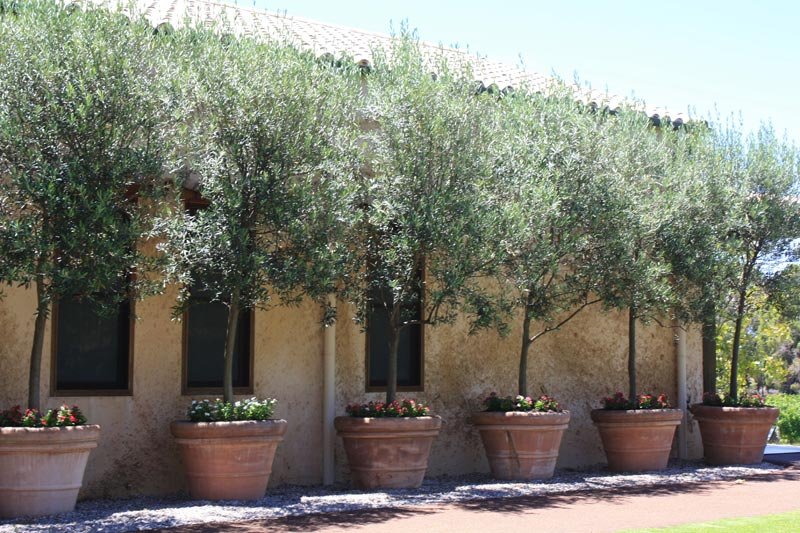Olive trees in pots: cultivation & care
In this article, we will talk about how to grow and care for olive trees in pots to ensure that you can enjoy the benefits of this beautiful species.

Olive trees are iconic trees of the Mediterranean, known for their delicious olives and scenic beauty. They are often associated with country life, but not everyone has the opportunity to have a large garden to grow fruit trees. However, the good news is that olive trees can be grown in pots and successfully cared for on a balcony or terrace.
Growing olive trees in pots is not only possible, but also very rewarding. In addition to providing a unique aesthetic, the olives they produce are of high quality and can be used to make homemade olive oil. In this article, we'll talk about how to grow and care for olive trees in pots to ensure that you can enjoy the benefits of this beautiful species, even if you don't have a large garden.
1. Benefits and problems of growing an Olive tree in pot
Growing an olive tree in a pot has several benefits. First of all, it is an excellent option for those who do not have enough space in their garden for a large tree. Potted olive trees are smaller and easier to care for than trees grown in the ground, which means they can be grown on balconies, terraces and patios.
Another benefit is that potted olive trees are portable, meaning you can move them to different locations based on light and temperature needs. They are also easier to protect in case of frost and extreme temperatures.
However, growing an olive tree in a pot also has its challenges. One of the main problems is that the roots of olive trees tend to be large and extensive, which means that they need enough space to grow. When grown in pots, the roots have limited space to grow, which can limit the growth and fruit set of the tree.
Another challenge is the need to regularly water the pots to prevent the soil from drying out and the roots of the olive tree from dying. Also, the pots can overheat in summer and damage the roots of the olive tree. To avoid this, it's important to choose large, quality pots and place them where they receive the right amount of light and shade.
2. How to care Olive tree in pot
Let's talk about the most important topic, and for which you have entered this post, and that is the care for a potted olive tree. We will analyze 5 of the most important care.
2.1 Watering
Correctly watering a potted olive tree is crucial for its health and growth. Olive tree pots should be well drained and the soil should be moist but not soggy. Overwatering can be just as damaging as underwatering.
To properly water a potted olive tree, follow these steps:
- Determine the frequency of irrigation: The frequency of irrigation will depend on the season and the climate. During the warmer months you will likely need to water more frequently, while in winter you can reduce the amount of water given to the olive tree. It is also important to consider soil moisture. Check if the soil is dry before watering.
- Use quality water: The water used to irrigate the potted olive tree must be of quality and at room temperature. Hard or chlorinated water can damage the roots of the olive tree, so it is advisable to let it rest before using it.
- Water Thoroughly: When watering, be sure to wet all the soil in the pot. It is best to water thoroughly and allow the pot to drain completely before watering again.
- Avoid excess water: Excess water can be detrimental to the potted olive tree. If the pot does not have good drainage, water will pool at the bottom, which can cause the roots of the tree to die. If the pot does not drain well, it may be necessary to transplant the olive tree to a larger pot with better drainage.
By following these steps, you can ensure that you properly water your potted olive tree and keep it healthy and strong.
2.2 Fertilization
Fertilizing a potted olive tree is important to provide the nutrients it needs to grow healthy and produce a good crop of olives. Here are some tips on how to properly fertilize a potted olive tree:
- Use a balanced fertilizer: Potted olive trees need a proper balance of nitrogen, phosphorus and potassium to grow properly. Use a slow-release fertilizer that contains these three nutrients in balanced proportions. It is also important to choose a fertilizer that is specifically designed for fruit trees.
- Apply the fertilizer at the right time: Apply the fertilizer during the olive growing season, which is generally from March to September. Avoid fertilizing during the winter, as tree growth stops during this season.
- Follow label instructions: Follow the instructions on the fertilizer label to determine the proper amount to apply. Often the amount of fertilizer needed will depend on the size of the olive tree and the pot.
- Apply the fertilizer correctly: Apply the fertilizer evenly on the surface of the soil. If possible, water the pot before applying the fertilizer to avoid burning the tree. It is also important not to apply too much fertilizer, as this can damage the olive tree.
- Check the pH of the soil: The pH of the soil in the pot should be slightly acidic, with a range between 6 and 7. If the soil pH is too high or too low, nutrients from the fertilizer may not be available to the olive tree. . You can check the pH of the soil with a soil test kit available at garden stores.
By following these tips, you will be able to properly fertilize your potted olive tree and help it grow healthy and produce a good harvest.
2.3 Soil
Choosing the right soil is essential for the healthy growth of a potted olive tree. The soil must provide a suitable environment for the roots of the olive tree and must have good moisture retention. Here are some recommendations on the best type of soil for a potted olive tree:
- Soil mix: A good mix for a potted olive tree is a combination of garden soil, peat, sand and perlite. Garden soil should be rich in nutrients and have good drainage. The peat helps retain moisture, while the sand and perlite improve aeration and soil drainage.
- Drainage: It is important that the pot have drainage holes to prevent water from collecting in the bottom of the pot. Stagnant water can damage the roots of the olive tree and cause diseases.
- Soil pH: The pH of the soil in the pot should be slightly acidic, with a range between 6 and 7. If the soil pH is too high or too low, nutrients in the soil may not be available to the olive tree.
- Nutrients: The soil must contain the necessary nutrients for the healthy growth of the olive tree, such as nitrogen, phosphorus and potassium. You can enrich the soil with organic fertilizer or slow-release fertilizer specifically for olive trees.
With everything said so far, you will have realized that the best type of soil for a potted olive tree is a mixture of garden soil, peat, sand and perlite with good drainage and a slightly acidic pH. By providing the right soil, you can help your olive tree grow healthy and produce a good crop of olives.
2.4 Lightning
Adequate exposure to sunlight is crucial for the growth and health of a potted olive tree. Here are some tips to make sure your olive tree gets the right amount of sunlight:
- Place your pot in a sunny place: The olive tree needs direct exposure to the sun for several hours a day, preferably 6 to 8 hours. Locate the pot in a location where it will receive as much sun as possible. In general, south orientation is the best option.
- Protect the plant from intense sunlight: Although the olive tree needs direct exposure to the sun, it is important to protect it from intense sunlight during the hottest hours of the day, especially in summer. This can be done by placing the pot in a semi-shaded area, or by covering it with an awning or umbrella.
- Rotate the pot: To ensure that all parts of the plant receive light, it is advisable to rotate the pot every two to three weeks. In this way, you prevent the leaves from yellowing or falling due to lack of light.
- Watch the exposure in winter: In winter, the hours of sunlight decrease and direct sunlight can also be less intense. Therefore, it is important to locate the pot in a place with good sun exposure during this time of year.
2.5 Pruning
Pruning is important to maintain the shape and health of a potted olive tree, as well as to control its size. Here are some tips to properly prune a potted olive tree:
- Choose the right time: The ideal time to prune a potted olive tree is in late winter or early spring, before the growing season begins. Avoid pruning in the summer or fall, as this can weaken the plant.
- Remove dead or damaged branches: Look for branches that are dry, damaged or diseased and remove them with a pruner or pruning shears. This will help prevent the spread of disease and maintain the health of the plant.
- Eliminate branches that cross or rub against each other: Branches that cross or rub against each other can cause friction and damage the bark of the plant. If you notice that there are branches that cross, remove the less healthy or less productive one.
- Control the size of the plant: If your potted olive tree is growing too large, you can control its size by pruning back some of the main branches. Try to maintain the natural shape of the plant and not cut more than 20% of the plant mass in a single season.
- Perform a training pruning: If you are growing a young olive tree in a pot, you can perform training pruning to give it a desired shape. To do this, cut back the side branches near the base of the plant, leaving just two or three strong branches to become the main branches.
Remember that each potted olive tree is unique and may require different pruning techniques depending on its size, shape and overall health. If you have questions about how to prune your olive tree in a pot, consult an expert or an experienced gardener.
3. Summary
First of all, it is important to choose a pot of the right size and well-drained soil. It is also necessary to water the plant properly, avoiding both a lack and excess of water.
On the other hand, fertilization is important for the growth and health of the potted olive tree. It is advisable to use organic fertilizers and apply them regularly.
Also, you should never stop paying attention to exposure to sunlight, since the olive tree needs light to grow and produce olives, but it can also be susceptible to sunburn.
Pruning is undoubtedly also important, it will help you maintain the shape and health of the olive tree, as well as to control its size. It is advisable to prune during winter or spring and remove dead, damaged, or diseased branches.
With this proper care, your potted olive tree can grow and produce healthy olives for many years.












